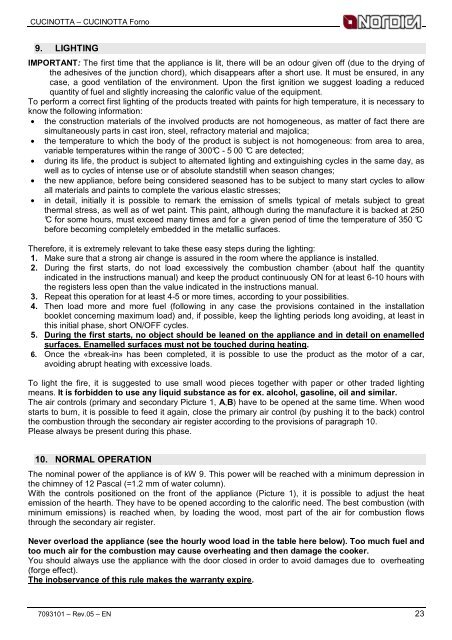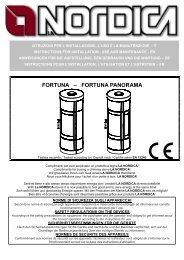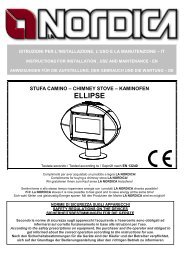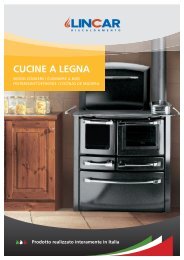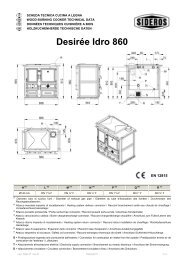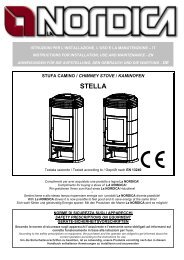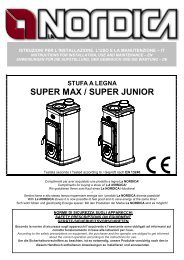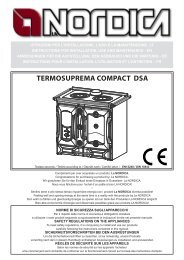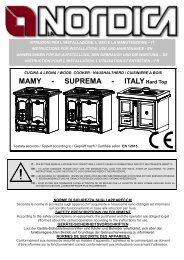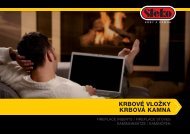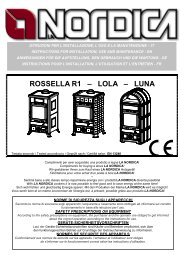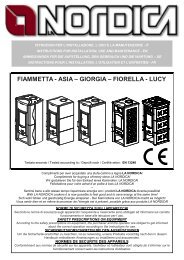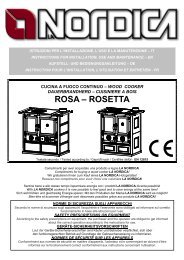CUCINOTTA / CUCINOTTA FORNO
CUCINOTTA / CUCINOTTA FORNO
CUCINOTTA / CUCINOTTA FORNO
You also want an ePaper? Increase the reach of your titles
YUMPU automatically turns print PDFs into web optimized ePapers that Google loves.
<strong>CUCINOTTA</strong> – <strong>CUCINOTTA</strong> Forno<br />
9. LIGHTING<br />
IMPORTANT: The first time that the appliance is lit, there will be an odour given off (due to the drying of<br />
the adhesives of the junction chord), which disappears after a short use. It must be ensured, in any<br />
case, a good ventilation of the environment. Upon the first ignition we suggest loading a reduced<br />
quantity of fuel and slightly increasing the calorific value of the equipment.<br />
To perform a correct first lighting of the products treated with paints for high temperature, it is necessary to<br />
know the following information:<br />
• the construction materials of the involved products are not homogeneous, as matter of fact there are<br />
simultaneously parts in cast iron, steel, refractory material and majolica;<br />
• the temperature to which the body of the product is subject is not homogeneous: from area to area,<br />
variable temperatures within the range of 300°C - 5 00 °C are detected;<br />
• during its life, the product is subject to alternated lighting and extinguishing cycles in the same day, as<br />
well as to cycles of intense use or of absolute standstill when season changes;<br />
• the new appliance, before being considered seasoned has to be subject to many start cycles to allow<br />
all materials and paints to complete the various elastic stresses;<br />
• in detail, initially it is possible to remark the emission of smells typical of metals subject to great<br />
thermal stress, as well as of wet paint. This paint, although during the manufacture it is backed at 250<br />
°C for some hours, must exceed many times and for a given period of time the temperature of 350 °C<br />
before becoming completely embedded in the metallic surfaces.<br />
Therefore, it is extremely relevant to take these easy steps during the lighting:<br />
1. Make sure that a strong air change is assured in the room where the appliance is installed.<br />
2. During the first starts, do not load excessively the combustion chamber (about half the quantity<br />
indicated in the instructions manual) and keep the product continuously ON for at least 6-10 hours with<br />
the registers less open than the value indicated in the instructions manual.<br />
3. Repeat this operation for at least 4-5 or more times, according to your possibilities.<br />
4. Then load more and more fuel (following in any case the provisions contained in the installation<br />
booklet concerning maximum load) and, if possible, keep the lighting periods long avoiding, at least in<br />
this initial phase, short ON/OFF cycles.<br />
5. During the first starts, no object should be leaned on the appliance and in detail on enamelled<br />
surfaces. Enamelled surfaces must not be touched during heating.<br />
6. Once the «break-in» has been completed, it is possible to use the product as the motor of a car,<br />
avoiding abrupt heating with excessive loads.<br />
To light the fire, it is suggested to use small wood pieces together with paper or other traded lighting<br />
means. It is forbidden to use any liquid substance as for ex. alcohol, gasoline, oil and similar.<br />
The air controls (primary and secondary Picture 1, A,B) have to be opened at the same time. When wood<br />
starts to burn, it is possible to feed it again, close the primary air control (by pushing it to the back) control<br />
the combustion through the secondary air register according to the provisions of paragraph 10.<br />
Please always be present during this phase.<br />
10. NORMAL OPERATION<br />
The nominal power of the appliance is of kW 9. This power will be reached with a minimum depression in<br />
the chimney of 12 Pascal (=1.2 mm of water column).<br />
With the controls positioned on the front of the appliance (Picture 1), it is possible to adjust the heat<br />
emission of the hearth. They have to be opened according to the calorific need. The best combustion (with<br />
minimum emissions) is reached when, by loading the wood, most part of the air for combustion flows<br />
through the secondary air register.<br />
Never overload the appliance (see the hourly wood load in the table here below). Too much fuel and<br />
too much air for the combustion may cause overheating and then damage the cooker.<br />
You should always use the appliance with the door closed in order to avoid damages due to overheating<br />
(forge effect).<br />
The inobservance of this rule makes the warranty expire.<br />
7093101 – Rev.05 – EN 23


